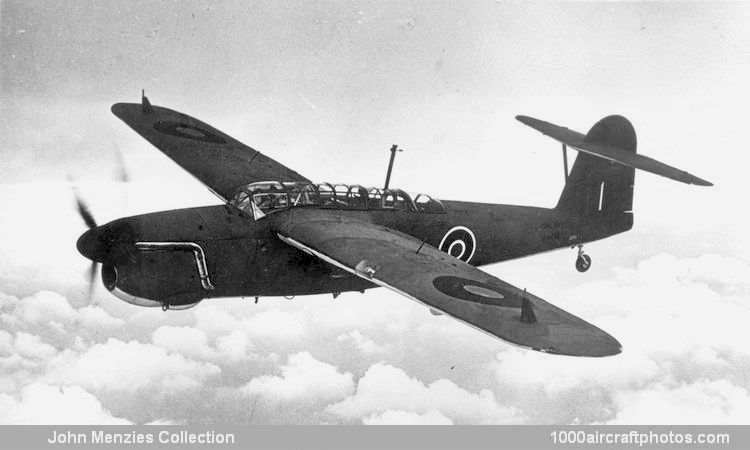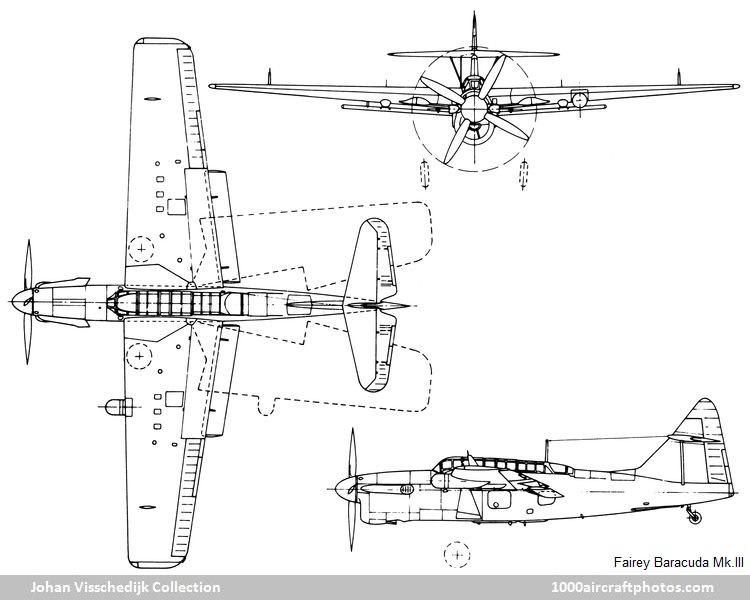Designed to meet the requirements of Specification S.24/37, the Fairey Type 100, as the Barracuda was originally known, was intended as a replacement for the Albacore biplane torpedo-bomber. Two prototypes serialed P1767 and P1770, were ordered on January 30, 1939, and the first flew for the first time on December 7, 1940. But because of the pressure of more urgent calls for other types of combat aircraft the design effectively remained on the shelf for a further two years, although the second prototype flew in June 1941.
Series production of the Barracuda Mk.I began in early1942 and the first production aircraft flew on May 18 that year. Only 25, powered by the 1,260 hp Rolls-Royce Merlin 30, were built. The Barracuda Mk.II was powered by the 1,640 hp Merlin 32, which became the most important model with 1,688 built. Production began during the latter part of 1942 at Fairey's Stockport factory, Blackburn at Brough, Boulton and Paul at Wolverhampton and Westland at Yeovil. The first of this variant entered service with 827 Squadron in January 1943 and a year later the Barracuda establishment in the Royal Navy had grown to twelve front-line squadrons.
Last of the wartime Barracudas was the Mk.III, generally similar to the Mk.II but equipped with ASV Mk.X radar for anti-submarine reconnaissance. A Mk.II, serialed DP855, was converted to prototype and flew in 1943. First production Mk.IIIs became available in early 1944 and finally 852 were delivered. Total wartime production (prototypes, Marks I, II and III) was 2,572 aircraft.
Although originally conceived as a torpedo-bomber, the Barracuda will be best remembered as a dive-bomber. One of the most famous Barracuda actions was the series of dive-bombing attacks against the German battleship Tirpitz in Kaafiord, Norway, between April and August 1944.
After VJ-Day most Barracuda squadrons were disbanded, with only three remaining operational by the beginning of 1946. A small force of Barracuda Mk.IIIs was formed in 1947 to perform the anti-submarine patrol role until the arrival of the Grumman Avenger in 1953.
Last of all the Barracuda variants was the Mk.V, again, earlier models were converted to prototypes, this time three Mk IIIs (PM940, PM941 and PM944). It was an almost entirely new aircraft, powered by a 2,020 hp Rolls-Royce Griffon in place of the earlier versions' Merlin. The aircraft was of all-metal construction and had a folding shoulder-wing with Fairey-Youngman trailing flaps and vertical tail of substantially altered shape. The three crew-members were seated in tandem under a large multi-glazed canopy. The rear-crewmember operated two 0.3 in (7.7 mm) Browning machine guns, further weapons were a combination of bombs, depth charges, mines or a torpedo up to a total of 1,640 lb (744 kg). Bringing the total of Barracudas built on 2,602, only thirty production Mk.Vs were built, serialed RK530 to RK542 and RK558 to RK574, the aircraft entered service in 1947, equipping only 750 Squadron at St. Merryn and 783 Squadron at RNAS Lee-on-Solent."
|
Type: |
Torpedo- and dive-bomber |

